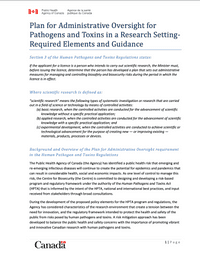
Languages: English, French
Plan for Administrative Oversight for Pathogens and Toxins in a Research Setting - Required Elements and Guidance
[Pathogens and Toxins in a Research Setting]
All Canadian institutions conducting scientific research related to human pathogens must submit a Plan for Administrative Oversight to explain the mechanisms that are in place to administratively manage and control biosafety and biosecurity risks. Because administrative accountability standards vary widely across research institutions, the Public Health Agency of Canada (PHAC) created these Guidelines for creating a Plan for Administrative Oversight Submissions. While the Guidelines are tailored specifically to meet the mandate of the Canadian Human Pathogens and Toxins Act (HPTA), they may be used as an example for improving institutional administrative oversight into biosecurity in other countries.
SUMMARY
All Canadian institutions conducting scientific research related to human pathogens must submit a Plan for Administrative Oversight (Plan) to explain the organizational mechanisms that are in place to administratively manage and control biosafety and biosecurity risks. Because administrative accountability standards vary widely across research institutions, the Public Health Agency of Canada (PHAC) created these Guidelines for creating a Plan for Administrative Oversight Submissions. The Guidelines outline ten common administrative elements that are required to be included in Plan submissions, including: 1) commitment from Senior Management to control biosafety and biosecurity risks; 2) delineation of roles and responsibilities; 3) establishment of a single point of contact and senior level employee in charge of championing biosafety issues; 4) an overview of how biosafety and biosecurity risks are identified; 5) an overview of how biosafety and biosecurity risks are assessed; 6) an overview of how biosafety and biosecurity risks are managed and controlled; 7) a description of all work areas covered by the Plan; 8) description of all individuals covered by the Plan; 9) summary of how the Plan is communicated; and 10) overview of the procedures to review and monitor the Plan.
The Public Health Agency of Canada focuses on preventing disease and injuries, responding to public health threats, promoting good physical and mental health, and providing information to support informed decision making. While these Guidelines are tailored specifically to meet the mandate of the Canadian Human Pathogens and Toxins Act (HPTA), they may be used as an example for improving institutional administrative oversight in biosecurity in other countries. This document is openly available online in English and French.

..png)
